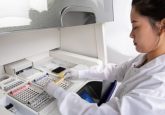The scientist and the machine: a story of lab automation

How has technology changed the way we conduct research? Lab automation takes many different forms with the purpose of streamlining several aspects of experiments, data collection and data analysis.
Lab automation can take many different forms, from robots to machine learning; but how can one harness the power of technology to increase consistency and efficiency when conducting research?
Lab automation can be a daunting concept; however, in a laboratory setting, it could aid throughput capabilities, reduce contamination, bypass human error and address the issue of reproducibility. When we talk about lab automation, we’re often talking about automating parts of a workflow. This means that parts of the technical process are augmented with automated equipment, such as a thermocycler in PCR or robotic sample transfer for plate replication or serial dilutions. However, there is also total lab automation, which refers to the complete automation of a laboratory process or workflow [1].
Robotic devices in the lab are often built and programmed to complete repetitive, simple tasks efficiently, allowing the people in the lab to work on other aspects of their research. By streamlining an essential and time-consuming step, research can be expedited, allowing for higher throughput, efficiency and product quality [1].
This article provides a snapshot of the types of automation systems currently available, how they can benefit research and whether automation is the next step for your lab.
Partial automation
Partial automation refers to the automation of a single step in a lab process, such as highly repetitive tasks. Tasks that have been identified as easily automated are centrifugation, aliquoting and colony counting, among other monotonous tasks. This type of automation still requires human oversight and can therefore only function during working hours. Designed for one specific part of a process, these automated systems are typically incompatible with other automated systems and software. Additionally, partial automation leaves more room for error than total lab automation [1].
Total lab automation
Automating an entire process or workflow in the lab is more complex as the automation has to encode more sophisticated processes, such as conveyor transport, robotics, analysis interfaces and sample storage systems [1].
Because total automation doesn’t require continuous human oversight, the systems can run at all hours, increasing throughput. It also allows researchers to control the entire process from a single user interface, which is compatible with all equipment in that process. This means researchers simply click ‘go’ and walk away from the automated system, freeing them up to continue with other work, and only need to come back to assess the results of the automation process when it’s complete [1].
Large system automation, outlined by Thermo Fisher Scientific (MA, USA), refers to the automation of complex processes that require multiple instruments. Large systems can be tailored to achieve various lab goals and can be applied to cell line development, biochemical assay development and protein expression studies. Automating at this scale requires multiple complimentary instruments that can handle precision workflows, such as robotic devices, incubators, collaborative platforms and software [2].
Regardless of lab automation stage, choosing the correct instrument or combination of instruments remains key to ensuring lab efficiency is increased, rather than hindered.
Modular lab automation
Where partial and total lab automation meet is modular automation, which is the composition of multiple pieces of equipment connected via automated tracks or robots [1]. Modular automation can address a lab’s desire to streamline instrument loading for sample preparation, PCR and flow cytometry, among other applications, via carefully selected robotic movers, automated incubators and software [2].
Another option is to automate a simple workflow, which involves more instruments and is therefore slightly more complex. This automation system could be applied to ELISA or extraction and purification protocols. Even though simple workflow automation requires the same types of technologies, i.e. robotic devices, incubators and software, it is essential that the correct combination of technologies is utilized. Companies, such as Thermo Fisher Scientific, bypass the issue of incompatibility often seen in partial lab automation by providing instruments that are complimentary [2].
When to implement automation
When it comes to considering whether or not automating is right for your lab, there are a few key things to consider. Deciding to automate, in all its daunting glory, can be broken down into three questions designed by Zymo Research (CA, USA), known as T Challenges: (1) the technical challenge, (2) the throughput challenge and (3) the turnaround time challenge. These challenges were created to help researchers assess whether automation is the right path for them [3].
The technical challenge asks researchers to consider whether they can automate their laboratory processes. Does the work require highly skilled individuals or can it be accomplished by an automated system? Repetitive tasks are easily automated, whereas challenging workflows typically require human insight and oversight. What is your lab trying to achieve? Is it a commercial lab or strictly educational? [3]
Next, researchers need to consider if they should automate. The throughput challenge urges researchers to assess how their throughput, or product output, would be affected by automation. In a commercial lab, if your manual lab processes aren’t meeting customer expectations and deadlines, then automation could be a beneficial implementation [3].
Finally, the turnaround challenge refers to the time it takes to get from sample to data. This can be done manually in shifts, but a robot could work round the clock, ultimately expediting the process, mitigating disparities in manual skills and maintaining the company’s consistency [3].
There are multiple factors to consider when deciding whether or not to automate. Sometimes automation is an unnecessary cost and won’t increase efficiency or throughput, so weighing all of your options is key for maximizing your lab’s success.
So, what do you think? Is lab automation right for your research? Time to start the ‘Pros & Cons’ list.
For more information about lab automation, check out our In Focus with Zymo Research.





